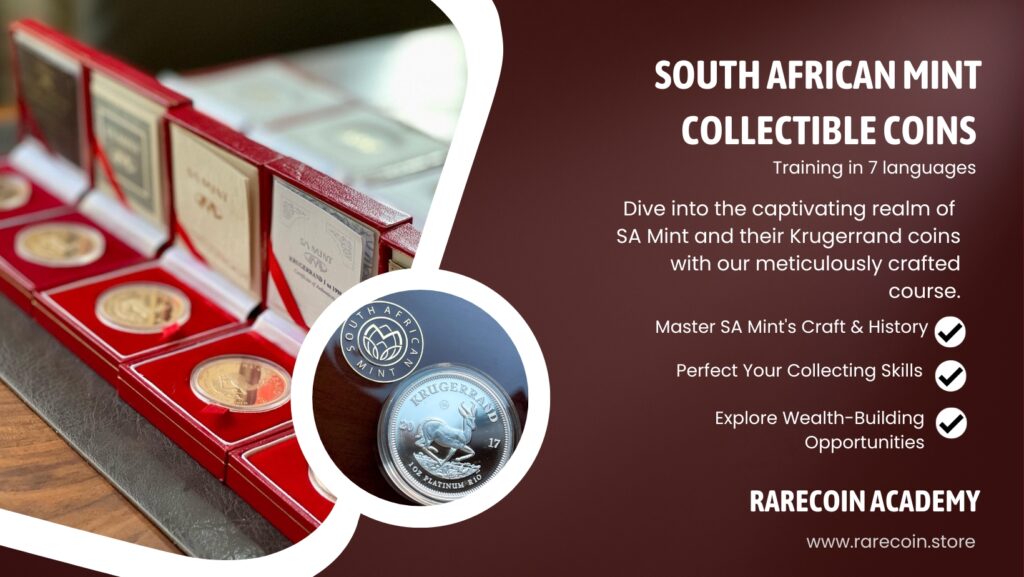
1.2. Krugerrand: collector coins vs. investment coins
The Krugerrand, a gold coin minted by the South African Mint, is available in two main forms: a collector’s coin and a bullion coin. Both types of coins have significant value, but differ in terms of their primary purpose, characteristics, and appeal to different groups of people.
Krugerrand collector coins:
The Mint typically mints Krugerrand collector coins in limited quantities and provides them with special designs, finishes or packaging. These coins are very popular among numismatists (coin collectors) and are considered works of art. Additionally, it is possible to have Krugerrand collector coins graded and certified/graded by third parties to confirm their condition and authenticity. Factors such as rarity, condition, historical significance and overall appeal to collectors play a critical role in determining their value. As a result, the price of Krugerrand collector coins is often (far) higher than the value of their gold content.
Bullion Krugerrand coins:
In contrast, bullion Krugerrand coins are primarily aimed at investors who purchase them for their gold content. These coins are typically produced in large quantities and feature a standardized design. They are not normally submitted to third parties for grading, with some exceptions . Their value is primarily determined by the current market price for gold. Bullion Krugerrand coins offer investors the opportunity to diversify their portfolio and hedge against inflation or economic downturns.
In addition, Bullion Krugerrand coins can also be of interest to collectors. This is particularly true of the first editions, which were produced in limited editions. Although their primary purpose is investment, the historical significance and rarity of the earlier issues also make them attractive to collectors who wish to add these special bullion coins to their collections.
The Krugerrand Chronicle: Unveiling the Secrets of the Manufacturing and Global Significance of Bullion and Proof Coins
The embossing process in comparison
The minting process differs between bullion coins and proof Krugerrands, both of which are produced by the South African Mint.
Bullion coins: These mass-produced gold coins go through a different process than proof coins, which are produced exclusively for collectors and minted in limited numbers. The minted bullion coins go back to the Rand Refinery for distribution, while the South African Mint exclusively markets and sells proof coins.
Features of Krugerrand Proof coins
The proof coins of the Krugerrand are characterized by reflective fields and matt motifs. In particular, the serrations on the edge of the proof coins (220) have been different from the bullion coins (180) since 1977. Proof coin dies are carefully prepared by sandblasting to obtain a matte design and then polished to achieve the unique combination of matte design and reflective fields. The Proof coins are minted multiple times to obtain precise definition, while the Bullion coins are minted only once.
Early years (1967-1969) and export
In the early years (1967-1969), a limited number of proof coins (10,000 per year) were minted and sold primarily to collectors. These early Krugerrand coins are rare and sought after and command a high price due to their gold content. A consortium of Swiss banks enabled the export of a small quantity of high-quality coins, recognizing the challenge of competing with well-known coins.
Mass production and international markets
Mass production of the Krugerrand began in April 1970 after approval was given for coins to be sold over the counter at local banks. Dr. AA “Attie” von Maltitz (chairman of the gold study committee at the Chamber of Mines), frustrated with slow sales, pushed for mass production. Reluctantly, 100,000 bullion coins were ordered and offered to the South African public for the first time in 1970. The first overseas launch was in West Germany, with skeptics eventually giving in to popular demand.
By 1978, Deutsche Bank AG had acquired its five millionth coin. From 1974 to August 1974, 1,740,000 Krugerrands were exported, with Germany, Great Britain, Switzerland, Canada, Belgium and Hong Kong among the active markets.
Summary: Collector coins and investment coins differ primarily in their external features and design.
Collectible coins :
- Often have special designs depicting historical events, personalities or cultural symbols.
- May have limited editions, special embossing processes or special surface treatments.
- Typically available in special packaging that highlights their beauty and collectible value.
- Often have a face value, but this is usually lower than their actual collector’s value.
Investment coins (bullion coins) :
- Typically have a simpler and standardized design, often showing the year of minting and the gold or silver content.
- Are produced in larger quantities and are not limited to a specific edition.
- Rarely have special packaging or surface treatments.
- The value of these coins is based primarily on their precious metal content and is determined by the current market price of gold or silver.
Summary: In conclusion, it can be said that Krugerrand coins have their own value and their specific target groups, both as collectors and as investment coins. While collector coins are popular with collectors due to their artistic design and rarity, bullion coins are characterized by their gold content and their suitability as an investment. Even if the bullion coins are primarily intended as an investment, they can also be of interest to collectors, especially the limited first editions.
Additional sources of information:
How much is a Krugerrand coin worth – the most expensive Krugerrand coins

